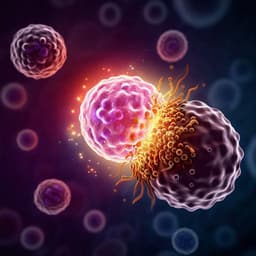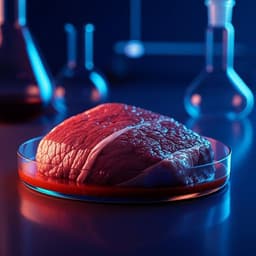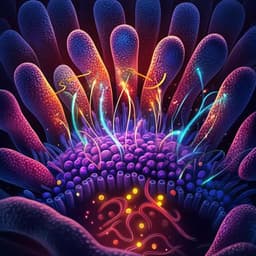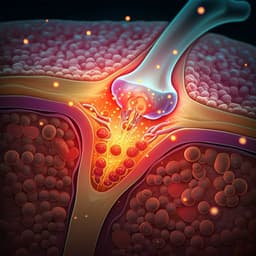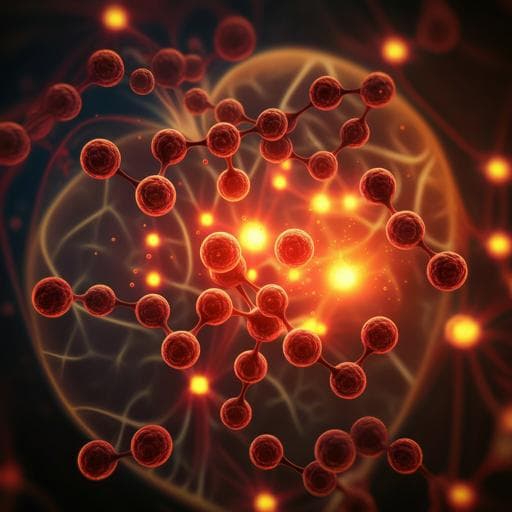
Medicine and Health
Electrophysiological engineering of heart-derived cells with calcium-dependent potassium channels improves cell therapy efficacy for cardioprotection
P. Vigneault, S. Parent, et al.
This innovative research by Patrick Vigneault and colleagues explores how calcium-activated potassium channels could revolutionize cell therapy for heart diseases. The study highlights the potent role of KCa3.1 in enhancing heart function and cell growth, offering promising avenues for cardiac protection and regeneration.
~3 min • Beginner • English
Introduction
Heart failure remains a leading cause of mortality despite advances in care. Paracrine-based cardiac cell therapies, including heart explant-derived cells (EDCs), can attenuate remodeling and improve function, but product potency is variable and reliable markers predicting therapeutic efficacy are limited. Membrane potential (Vmem) and intracellular Ca2+ dynamics strongly influence stem/progenitor cell behavior. Prior work showed that the intermediate-conductance Ca2+-activated K+ channel KCa3.1 (encoded by KCNN4) couples to store-operated Ca2+ entry (SOCE) to hyperpolarize membranes, increase Ca2+ driving force, and enhance Ca2+ influx in mesenchymal stem cells and cardiac c-Kit+ cells. The authors hypothesized that KCa3.1 activity shapes the therapeutic phenotype of human EDC subpopulations and that overexpressing KCNN4 would optimize Vmem during SOCE, augment Ca2+ signaling, and thereby improve EDC proliferation, paracrine output, and in vivo cardioprotective efficacy.
Literature Review
- EDCs are intrinsic cardiac CD105+ cells with demonstrated paracrine-mediated benefits; clinical comorbidities can reduce potency, and CD90− subfractions have been implicated as the therapeutically active population (Cheng 2014; Shen 2018).
- KCa3.1 channels regulate proliferation and Ca2+ handling in multiple progenitor/stem cells; KCa channels broadly influence development and adult stem cell function (Vigneault 2018; Levin 2014; others cited 26–30).
- Membrane potential modulates proliferation and differentiation across stem cell types (Sundelacruz 2008/2013; Ng 2010; others).
- Prior cell therapy enhancements have focused on paracrine factor overexpression (e.g., SDF-1α, IGF-1) or survival genes; electrophysiological engineering to increase therapeutic effectiveness had not been explored in EDCs. Previous electrophysiological modifications in skeletal myoblast therapy addressed arrhythmogenicity rather than efficacy and had mixed outcomes.
- Extracellular vesicles (EVs) from cardiac cell products are key mediators of benefit; modifying secretome/EV content is a viable strategy to enhance repair.
Methodology
- Human cell source and culture: EDCs were generated from left atrial appendage biopsies from consented patients undergoing cardiac surgery under IRB approval. Biopsies were minced, collagenase-digested, and plated in MSC Nutristem XF at 5% O2. EDCs spontaneously emerged and were collected weekly for 4 weeks.
- Lentiviral engineering: EDCs were transduced to overexpress KCNN4 (KCa3.1) or empty vector (EV); nontransduced (NT) EDCs served as controls. Multiplicity of infection was 20. KCNN4 expression was quantified by RT-qPCR (2−ΔΔCt normalized to GAPDH).
- Electrophysiology: Whole-cell patch-clamp and perforated-patch recordings at 37 °C quantified ion currents and Vmem. BKCa current was identified by paxilline sensitivity; KCa3.1 current (IKCa3.1) was identified by TRAM-34 sensitivity. Current densities were normalized to capacitance (pA/pF). SOCE was induced by Ca2+-free external solution with EGTA, followed by reintroduction of 1.8 mM Ca2+. CD90+ cells were prospectively labeled with fluorescent anti-CD90 antibody to study CD90+ versus CD90− subpopulations.
- Ca2+ imaging: Fluo-4 AM–loaded EDCs (KCNN4 vs EV) were imaged by confocal microscopy to assess basal intracellular Ca2+ levels.
- In vitro phenotype under stress: Cells were exposed to ischemia-mimicking conditions (1% O2, nutrient deprivation, ± H2O2). Proliferation was measured by WST-8, manual counts, and Ki67/DAPI. Apoptosis/necrosis were assessed by Annexin V/7AAD flow cytometry. Intracellular Ca2+ dependence was tested using BAPTA-AM.
- Paracrine profiling: Conditioned media (48 h, 1% O2, exosome-free serum) were analyzed by cytokine array (Human XL Cytokine Array). EVs were isolated by differential ultracentrifugation and quantified by nanoparticle tracking analysis; EV miRNAs were profiled by Nanostring (Human v3), analyzed with TMM normalization and EdgeR GLM LRT.
- In vivo efficacy: Male NOD/SCID IL2Ry mice underwent LCA ligation (MI). One week later, mice were randomized (blinded) to intramyocardial injection (two 14 µL deposits at apex and border zone) of 1×10^5 NT-EDCs, KCNN4-EDCs, EV-EDCs, or vehicle. Echocardiography assessed ejection fraction at baseline, 1 week post-MI, and endpoints. Invasive LV hemodynamics (Millar catheter) measured dP/dtmax/min and pressure–volume relationships. Histology quantified infarct size (Masson-Trichrome), infarct wall thickness, viable tissue in risk area, and vessel density (isolectin B4). Proliferation (BrdU), macrophage polarization (CD68, CD163), apoptosis (cleaved caspase-3), and cardiomyocyte proliferation (BrdU+/cTnT+) were assessed. Human cell retention was quantified by qPCR for human alu sequences and immunohistochemistry for human nuclear antigen. Telemetry and programmed electrical stimulation assessed arrhythmia susceptibility.
- Subpopulation engineering study: CD90+ and CD90− fractions were isolated by magnetic sorting; each was transduced with KCNN4 or left NT, then either injected separately or recombined to test synergy and necessity of mixed populations.
- Statistics: Randomized, blinded analyses; data as mean ± SEM; two-sided tests; one-way ANOVA (with Bonferroni multiple comparisons), two-way repeated-measures ANOVA for repeated measures; Fisher’s exact test for categorical; significance P<0.05.
Key Findings
- Endogenous currents: Both CD90+ and CD90− EDCs exhibited Ca2+-dependent K+ currents with outward rectification. Reversal potentials differed: −51 ± 5 mV (CD90+) vs −75 ± 5 mV (CD90−), P<0.01, indicating distinct ion channel profiles despite similar current densities.
- BKCa vs KCa3.1: Paxilline (BKCa blocker) reduced outward currents but did not alter resting Vmem. TRAM-34 (KCa3.1 blocker) eliminated differences between subpopulations, revealing substantial TRAM-34–sensitive IKCa3.1 in CD90− and negligible in CD90+ cells.
- Resting membrane potential: Vmem was more depolarized in CD90+ vs CD90− cells (−25 ± 2 mV vs −64 ± 7 mV; P<0.001). TRAM-34 depolarized CD90− Vmem to levels similar to CD90+ but had no effect on CD90+.
- SOCE coupling: During SOCE, reintroduction of 1.8 mM Ca2+ hyperpolarized CD90− cells from −25 ± 3 mV to −67 ± 3 mV (P<0.001); TRAM-34 suppressed this hyperpolarization, demonstrating KCa3.1 control of Vmem during Ca2+ entry.
- KCNN4 overexpression: Lentiviral transfer increased KCNN4 mRNA ~20-fold versus EV. IKCa3.1 density increased and Vmem hyperpolarized similarly in CD90+ and CD90− cells (to −77 ± 2 mV and −81 ± 2 mV). Basal intracellular Ca2+ increased in KCNN4-EDCs versus EV controls.
- In vitro phenotype under stress: KCNN4-EDCs showed increased proliferation under ischemia-mimicking conditions (vs EV and NT), without changes in apoptosis/necrosis. Chelating intracellular Ca2+ with BAPTA-AM markedly reduced KCNN4-EDC proliferation and cell numbers, underscoring Ca2+ dependence.
- In vivo cardiac function: After MI, KCNN4-EDC treatment improved ejection fraction and invasive hemodynamics (higher dP/dtmax, less negative dP/dtmin) more than EV-EDCs and NT-EDCs (all treatments > vehicle; KCNN4 > EV/NT). Benefits persisted beyond 4 weeks in a separate cohort.
- Structural remodeling: KCNN4-EDCs reduced infarct size, increased infarct wall thickness, and increased viable myocardium within the risk area versus vehicle and EV/NT. Peri-infarct vessel density increased. M2 macrophages increased; apoptotic markers and M1 macrophages decreased. BrdU+ proliferative cells (including BrdU+/cTnT+ cardiomyocytes) increased.
- Cell retention: Long-term engraftment increased by 3 ± 1-fold (human nuclear antigen IHC; P<0.05) and 7 ± 2-fold (human alu qPCR; P<0.01) versus NT-EDCs at 21 days.
- Electrophysiological safety: No adverse effects on ECG conduction or repolarization; no inducible ventricular arrhythmias in EDC-treated groups (one vehicle animal inducible).
- Subpopulation engineering: Depleting CD90+ alone did not improve outcomes (NT CD90+ = NT CD90−). Overexpressing KCNN4 in isolated CD90+ or CD90− alone did not significantly improve outcomes. Only recombined KCNN4-EDCs (CD90+ plus CD90−) improved outcomes, suggesting synergy within the mixed product.
- Secretome and EVs: KCNN4 overexpression increased the abundance (not number) of several cytokines already present (6 vs 1 increased cytokine; χ2=3.78, P=0.05), including factors linked to angiogenesis (e.g., VEGF), healing (angiogenin, IGFBP-3, SDF-1α), and immune modulation (ICAM-1). EV production increased 1.6 ± 0.2-fold (P<0.05) with similar mean size (~133 ± 5 nm). EV miRNA cargo changed modestly: vs NT, 4 miRNAs decreased (Padj<0.05, |FC|>1.5); vs EV, 16 miRNAs altered (Padj<0.05, |FC|>1.5), mapping to pathways including TGF-β and Hippo signaling, ECM turnover, and cell-cycle regulation.
Discussion
Findings demonstrate that KCa3.1 channels are a key determinant of EDC bioelectric state and Ca2+ handling, selectively enriched in the therapeutically active CD90− subpopulation where they hyperpolarize Vmem during SOCE to enhance Ca2+ influx. Engineering mixed-population EDCs to overexpress KCNN4 equalized and hyperpolarized Vmem across subtypes, increased basal intracellular Ca2+, and boosted proliferation, leading to greater engraftment and enhanced paracrine activity (cytokines and EVs). In vivo, these changes translated into superior functional recovery, reduced infarct scar, increased neovascularization, and evidence of cardiomyocyte and nonmyocyte proliferation, without pro-arrhythmic effects. The lack of benefit when engineering isolated CD90+ or CD90− subfractions alone, versus the benefit with recombined engineered mixtures, suggests that inter-subtype crosstalk is necessary for optimal paracrine and reparative synergy. Overall, tailoring plasma-membrane ion-channel function can modulate progenitor cell signaling and behavior to improve therapeutic efficacy, supporting electrophysiological engineering as a broadly applicable strategy for regenerative therapies.
Conclusion
This study identifies KCa3.1 (KCNN4) as a functional marker and regulator of therapeutically potent EDCs and shows that electrophysiological engineering to overexpress KCNN4 enhances Ca2+ signaling, proliferation, paracrine output (cytokines and EVs), cell retention, and cardioprotection in a murine MI model. The work provides proof-of-concept that modulating ion-channel activity can improve the effectiveness of adult progenitor cell therapies. Future research should: (1) delineate molecular pathways linking KCa3.1-driven bioelectric changes to secretome remodeling; (2) evaluate non-integrating vectors or transient modulators suitable for clinical translation; (3) test efficacy and safety in immune-competent, large-animal models and across delivery time windows (chronic scar); and (4) assess generalizability to other progenitor cell types and disease indications.
Limitations
- Mechanistic depth: While KCNN4 increased proliferation and altered secretome/EVs, the precise downstream molecular pathways remain incompletely defined.
- Vector choice: Lentiviral integration poses potential insertional mutagenesis risks, limiting direct clinical translation; alternative vectors or non-genetic modulators are needed.
- Model constraints: Human cells were tested in immunodeficient mice; immune interactions and clearance in immune-competent or allogeneic settings may differ.
- Timing: Cells were delivered 1 week post-MI (analogous to ~1 month clinically); effects in chronic, extensively scarred myocardium require evaluation.
- Subpopulation dynamics: Benefits required recombined engineered mixtures; mechanisms of inter-subtype synergy were not fully elucidated.
Related Publications
Explore these studies to deepen your understanding of the subject.



